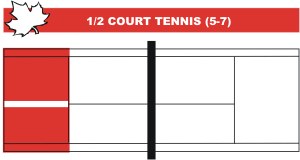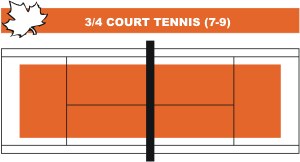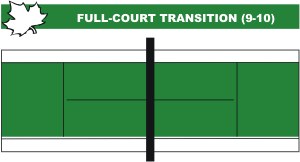|
TennisOne Lessons Developing Tactical Decision-Making Skills For ½ Court Players (5-7 year olds) Wayne Elderton No, the title isn’t a typo. It is not only possible to develop tactical decision-making skills in 5-7 year old players, it is necessary for a good tennis foundation. The fact is, no matter what the age or level, players will make decisions when they play. Training them is better than leaving them to chance.
When a coach or a commentator says something like, “that is a natural ability, you can’t teach that!” What they really mean is, “I have no idea how it could be trained.” Decision-making is trainable if one knows how. Before we get into the details, let’s review where we have come from… ‘Progressive Tennis’ is the Canadian name of the system of graduated court size, balls, racquets, and scoring for under 10 year-old players. In the US, this system is called ‘Quick Start.’ Progressive Tennis comes in 3 key steps (internationally color coded):
Our series has been about ½ Court development for 5-7 year olds. We have looked at the first two levels of the 3-step development pathway:
In the Bronze level, we split the development into 4 key ‘Skill Blocks’:
The Silver Level took players form that point, and added an additional 4 Skill Blocks of development:
Now, we will finish the series with this final block (I will save the Gold level for another year). How to Develop Tactical Decision-making? There are two steps in developing tactical decision-making skills, where and when. The first step (Where) is all about intention. This has been developed in all the previous Silver Skill blocks. It is developed by ensuring all skills have a tactic attached. This is central to a game-based approach. Tactics are connected to techniques rather than taught as ‘isolated’ skills (as done in traditional coaching). Typically, if decision-making is trained at all, it is done with what our former National Coaching leader, Louis Cayer calls, “Make up your mind drills.” Players simply decide what they want to do with the ball. Although most decision-making programs and drills end here, intention is only the first step. To really learn decision-making, the next step is critical. Intention is about where to hit the ball and must turn into true decision-making which is all about choosing when to hit the shot. This is required since tennis is a game. Games need to be played with strategies and tactics designed to win the contest. Tennis is not golf. Sending the ball is not all that’s going on. Everything required to receive the ball (called “Reception”) is critical in tennis. Traditional coaching would typically spend all the time developing great strokes form a static position (the ball was fed nicely by the coach). This is not the reality of the game and isn’t even a particularly effective first step in learning to play. The key coaching tools to help players learn decision-making are:
Strategy: Playing the Backhand In the Silver program, the key strategy highlighted is to play an opponent’s weaker side (typically the backhand). This is one of the oldest and time-tested strategies a player can perform, so it is a good place to start (they have already learned about keeping the ball in play as a strategy). Drill 4.1: Tactic - When to Use Crosscourts or Down-the-lines The goal in this drill is to pick on the opponent’s backhand. The player can receive shots on both forehand and backhand sides however, to direct it to the opponent’s backhand, they must practice hitting a crosscourt when receiving balls on their backhand side and a down-the-line when receiving balls on the forehand side (right-hander). The other benefit to practicing tactics in a ‘live ball’ drill where players cooperate with each other is, the other side of the tactic is also trained (e.g. how to move the ball around when someone is playing your backhand). Drill 4.2: Tactic - When to Use Your Forehand in the Center
This is a common tactic seen in every professional match (so why not get the kids into it?). When the ball comes into the center of the court, the player should use their strong forehand and direct it to the opponent’s backhand. This adds additional pressure to the opponent’s backhand. The trick is the quick recognition that the ball will be received in a position where the player is able to ‘run around their backhand.’ Drill 4.3: Tactic - When to Play To the Open Forehand Of course, only going to the backhand becomes predictable. The opponent is pinned into their backhand corner, and to really mess them up, a player needs to know when to go for the open forehand corner.
Once players get the hang of it, it is important to train them to initiate these tactics right from the serve and return. Starting points strong is a great skill to build. Conclusion Developing 5-7 years olds in a Progressive Tennis format is recommended by the International Tennis Federation (ITF). Their world-wide Play & Stay initiative (and the USTA Quick Start Initiative in the US) will help more players get better faster. Armed with these basic decisions, players can have a very advanced looking game even on a ½ Court. Imagine how experienced and masterful a player would be at 14 years old if this is how they played at 7? A recent study indicated that children nowadays are making the choice for their main sport between the ages of 9-11. If tennis is not able to capture them and establish them as solid players quickly, their choice will be some other sport. They will typically choose their sport based on the mastery they feel. Your comments are welcome. Let us know what you think about Wayne Elderton's article by emailing us here at TennisOne.
|



 Wayne Elderton
Wayne Elderton